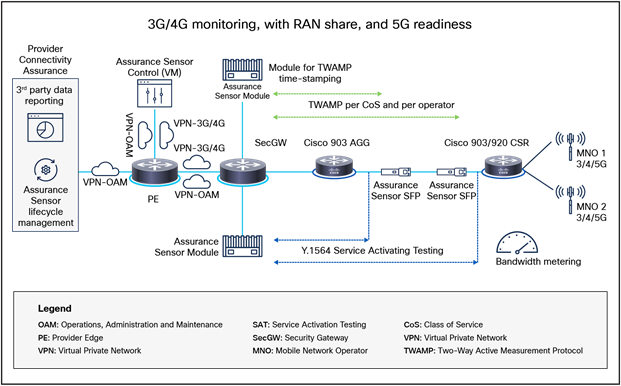Driving 5G Readiness and In-service Monitoring for Mobile Operators Use Case
Available Languages
Bias-Free Language
The documentation set for this product strives to use bias-free language. For the purposes of this documentation set, bias-free is defined as language that does not imply discrimination based on age, disability, gender, racial identity, ethnic identity, sexual orientation, socioeconomic status, and intersectionality. Exceptions may be present in the documentation due to language that is hardcoded in the user interfaces of the product software, language used based on RFP documentation, or language that is used by a referenced third-party product. Learn more about how Cisco is using Inclusive Language.
As operators roll out more 5G xHaul and core network solutions, as well as standalone 5G, mobile networks will need to support faster 5G speeds and stricter performance requirements, increasing cell site capacity to at least 10Gbps.
Among the challenges facing operators readying their networks for 5G are:
● Finding a single solution to verify readiness, provide insight on testing and correcting transport issues, and to continuously monitor in-service (i.e. full lifecycle approach).
● Current tooling for performance monitoring is not granular enough to assure that the network can support strict SLAs (packet loss and latency sensitive requirements of new service slices).
● High operational cost of site visits involving initial service activation testing.
● Need to minimize carbon footprint for all service rollouts.
● Global operators are upgrading mobile backhaul to support 5G speeds and performance requirements, increasing cell site capacity to 10Gbps.
● They require a single technology partner to verify 5G network readiness, test and correct transport issues, and monitor continuously in-service per slice.
● Cisco Provider Connectivity Assurance (formerly Accedian Skylight) provides fully automated discovery and deployment, initial service activation testing, and highly granular in-life performance monitoring of new services.
● The Provider Connectivity Assurance Sensor SFP (formerly Accedian Skylight SFP compute sensor) can be deployed in a highly efficient, low cost, and scalable way for assurance and troubleshooting.
● Minimize 5G slice deployment/enablement costs and maximize deployment quality through remote testing capabilities per-slice and per‒Class of Service (CoS).
● Operators partnering with Cisco Provider Connectivity Assurance can accelerate 5G rollouts with confidence, prioritizing which slices they can go live with and in what order.
● First-time-right deployment process and continuous in-service monitoring help to minimize operational costs and Mean Time to Repair (MTTR), plus maximize customer satisfaction.
● Operators now have the confidence they need to offer value-added services and meet strict business SLAs to differentiate and drive profits.
Solving 5G readiness challenges with Cisco Provider Connectivity Assurance
The Provider Connectivity Assurance platform offers a multi-layered architecture featuring the following key elements: the AI-enabled analytics engine and graphical user interface with built-in sensor management capabilities, a range assurance sensors in software or hardware form factors, and a data collector for ingestion of model-driven telemetry and other sources of third party performance data.

5G readiness-automating site turn-up with Provider Connectivity Assurance
Provider Connectivity Assurance Sensors can be deployed in a highly efficient, low cost, and scalable way. A single Assurance Sensor SFP device, for example, can monitor thousands of destinations through hundreds of VLANs or Virtual Routing and Forwarding instances (VRFs), effectively assuring and troubleshooting both physical and virtual layers.
Provider Connectivity Assurance delivers the following:
● Fully automated discovery and deployment, and initial service activation testing. Operators can turn on a site and start performance monitoring as soon as the site communication is available, minimizing the number of site visits.
● Any transport issues can be detected and corrected to an optimal level before enabling live service of the slice.
● The same solution can be used for ongoing in-life performance monitoring of new services (active monitoring for packet loss, jitter, delays, etc.).
● Flowmeter bandwidth metering for microburst detection (1ms sampling rates).
● Lowest sample rate and highest accuracy in the industry for time-based KPIs.
● Unique combination of active and passive monitoring techniques available within the solution for full L2‒L7 stack visibility, for the network and application/service layer.
● Unified view for visualization, reporting, and analytics of all active and passive monitoring data, plus third-party data.
● Real-time telemetry feed of performance KPIs to Software-Defined Networking (SDN) controllers and slice orchestrators supporting tangential closed-loop automation use cases.
● Single solution for 3G/4G in-life monitoring and 5G readiness, plus 5G in-life monitoring.
For its mobile operator customers Provider Connectivity Assurance can offer performance monitoring of 4G and 5G from a single solution—driving deployment and operational cost savings, plus ease-of-management. There is a range of other business benefits pre- and post-5G service activation including:
● Accelerates 5G rollouts with rapid time-to-market for new services and the agility to react to new marketing campaigns.
● Gives operators the confidence that services will work before going live. This builds brand reputation, improves end-user Quality of Experience (QoE), and reduces customer churn.
● Minimizes operational costs and MTTR for any issues and maximizes customer satisfaction by ensuring “first-time-right” deployment process and continuous in-service monitoring to detect any anomalies as the service ramps up.
● Gives operators the confidence to offer value-added services and meet strict business SLAs to differentiate and drive profits. These are all important for higher revenue enterprise customers and private network campus deployments.
The opportunities for Cisco Provider Connectivity Assurance to add value don’t end there.
Containerized Provider Connectivity Assurance Sensor Agents can run on a range of different devices—including edge compute appliances, mobile handsets, and cloud installations—to drive enhanced visibility. Provider Connectivity Assurance also has AI-enabled predictive performance analytics capabilities and end-customer portal options. These could be packaged up by operators and offered to end customers to help them visualize the services and customer experience they deliver. Machine learning-powered analytics drive improved visibility, rapid troubleshooting, and pre-emptive fixes to keep KPIs on track.
For more information on the Cisco Provider Connectivity Assurance solution, please visit cisco.com.